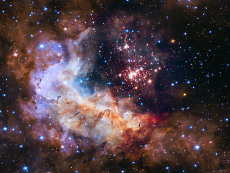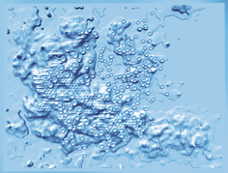About This Image
This illustration shows the Westerlund 2 image and the 3D Tactile print derived from the HST data. Three prints are available: Upper half of the W2 3D print, Lower half of the W2 3D print, and the 3D print with No Split.
The tactile print was provided by the 3D Astronomy Project at STScI which makes star cluster and galaxy imagery available in 3D tactile representations outfitted with textures to distinguish specific features in the celestial object. The 3D prints are produced through an innovative process (Christian et al 2015, Grice et al 2015) for the star clusters Westerlund 2 (Zeidler 2015), NGC602 and others as well as several galaxies.
The purpose is to stimulate an understanding of and interest in astronomical phenomena for any person but especially persons with blindness or visual impairment (B/VI) and individuals who are tactile learners. 3D Astronomy does address the need for assistive materials for individuals with B/VI in particular. 3D prints of HST astronomical data are produced using the research analysis of the observations and transforming the science data into 3D prints.
Image intensity is used as a surrogate for the mass distribution and textures are used to distinguish various features in the astronomical objects. Customarily, in visualization images, intensity and colors are used to highlight the astrophysics and so intensity and color are transformed into print “elevation” and colors into textures.
For a star cluster such as Westerlund 2, a “2.5 D” image is produced considering that much of a star cluster central region can be tenuous gas, which is difficult to print, as structure holding the stars in place are difficult to interpret for visually impaired individuals. Print files in STL format from 3D Astronomy are released periodically on the Public 3D Astronomy Page.
CREDITS:
NASA, ESA [link], and C. Christian, A. Nota, and collaborators (STScI)
REFERENCES:
Christian, C.A, Nota, A., Greenfield, P., Grice, N., Shaheen, N. 2015, “You Can Touch These! Creating 3d Tactile Representations Of Hubble Space Telescope Images”,Journal and Review of Astronomy Education and Outreach, 3, retrieved from http://www.toteachthestars.net/JRAEO/issue-3/.
Grice, N.; Christian, C.; Nota, A.; Greenfield, P. 2015, “3D Printing Technology: A Unique Way of Making Space Telescope Images Accessible to Non-Visual Learners”. Journal of Blindness Innovation and Research, Vol. 5, No 1. https://nfb.org/images/nfb/publications/jbir/jbir15/jbir050101abs.html
Zeidler, P. et al 2015, A.J. 150, 78.


